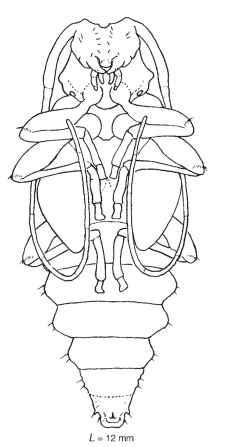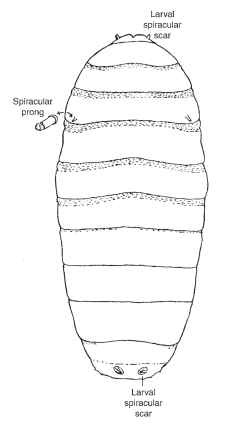Apupa is the stage in the development of holometabolous insects between the mature larva and the adult wherein major morphological reorganization takes place. Pupation usually occurs in a protected location (in a cell or cocoon), but in some groups, such as many butterflies, the pupa (chrysalis) is suspended openly and is usually well camouflaged by its shape and color.
There are two basic kinds of pupae, exarate (Fig. 1) and obtect (Fig. 2). An exarate pupa has free appendages. An obtect pupa has the appendages adhering to the body wall. Most Lepidoptera, most lower Diptera, some chrysomelid and staphylinid beetles, and many chalcidoid Hymenoptera have obtect pupae; nearly all other pupae are exarate.
BEHAVIORS
Most pupae are inactive, their body movements often limited to the abdominal segments. However, pupae in some groups are capable of locomotion, and some have functional mandibles that enable them to cut their way out of the pupal cell, cocoon, or chamber. These

FIGURE 1 Exarate pupa of long-horned wood-boring beetle (Cerambycidae), showing free appendages (ventral).

FIGURE 2 Obtect pupa of the monarch butterfly, Danaus plexip-pus, with appendages adhering to the body wall (lateral). The ready-to-emerge adult can be seen through the cuticle.
active pupae are sometimes referred to as pharate adults because the adult is enclosed in the pupal cuticle.
DESCRIPTION
Pupae may have articulated mandibles (decticous) or nonarticu-lated mandibles (adecticous). Decticous pupae are capable of chewing their way out of cells or cocoons and may be active. They occur in the Mecoptera (scorpionflies), Megaloptera (dobsonflies and fishflies), Neuroptera (lacewings, antlions, and relatives), Raphidioptera (snakeflies), Trichoptera (caddisflies), and primitive Lepidoptera (Micropterigidae).
In the higher Diptera (Muscomorpha: Schizophora), the exarate pupa (also called a coarctate pupa) is enclosed in a delicate membrane within the hardened and barrel-shaped last (third) larval skin termed the puparium (puparia) (Fig. 3), which surrounds and protects the pupa. The adult fly emerges by forcing the end of the puparium off with the ptilinum, a membranous eversible pouch between the eyes and above the antennae that is expanded outward by blood pressure from the abdomen and thorax. After emergence, the ptilinum is withdrawn into the head, resulting in the frontal suture that arches over the antennae. If the puparium is buried in the soil, the ptilinum may also be used to help the adult fly crawl or force its way to the surface.

FIGURE 3 Puparium of a higher fly, formed from the last larval skin, showing the larval spiracular scars and pupal spiracular prongs that anchor the exarate pupa within (dorsal).
A prepupa is the last instar that has completed feeding. It may wander in search of a pupation site, but generally it becomes nonmo-bile before pupation. It is easily observed in Lepidoptera, wherein the mature larva becomes shortened and the prolegs and crochets become progressively retracted before pupation.
